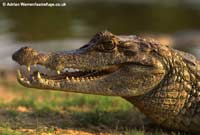
Of the six living Caiman species, Caiman crocodilus is the most widespread, being distributed in South and Central America, parts of the Caribbean, and has even been introduced into the United States. Over much of its range C. crocodilus is abundant, with over one million animals currently living in the wild.4
Caiman crocodilus prefers wetland and riverine habitats, usually those with slow moving water; although it has adapted to nearly all wet lowland areas. "C. crocodilus is restricted to the tropical lowlands; the limits of its range coinciding with the annual isotherm of 24°C. The highest reported sighting was at 800 m in Colombia. C. crocodilus can be found in a variety of habitats from rivers, creeks, lagunas and estuaries in forest or savannah areas to bogs and brackish mangrove swamps in coastal areas. They prefer calm, often turbid waters, with floating or emerging vegetation. Most habitats have marked seasonal flooding and dry periods, the animals congregating in the remaining bodies of water during the dry season. Which part of the habitat caiman use and when depends on their age and sex."5
Most
of the caiman’s diet is composed of other vertebrates, including fish,
amphibians, reptiles, birds, and some mammals. "Neonates feed on aquatic and
terrestrial insects, expanding to include crustaceans, molluscs and fish as
they grow. The basic adult diet varies from place to place, and includes fish and crustaceans, or a combination of molluscs, crustaceans
and fish. Full-sized adults also prey on mammals, semi-aquatic or
aquatic reptiles, and birds. They also eat carrion."
C. crocodilus takes at least six
years to reach sexual maturity, corresponding to an approximate overall length
of 114 cm (approximately 60 cm snout/vent). Courtship and mating coincide
with the onset of the rains. Gonads begin to increase in size towards the end of the dry season (April to May) and peak at the start of the wet season (May to June). The female then builds her nest - a mound of earth
and plant matter, some 40 cm high and at least 1 m in diameter - on a site near
water but not subject to flooding, often building over an earlier nest. She lays a clutch of eggs, with the number of eggs ranging from 12 to 44
with a mean clutch size of 29, depending on female body size. During the
65-84 day incubation period (various authors), the female guards the nest. The
hatchlings emerge with the oncoming dry season, measuring 20-23 cm in length, and the mother remains with them during the first few
months of life.7 The male guards the nest until the babies hatch. The mother then carries them to the water. The family stays together for about a year.8
Within the group Crocodylia, caimans are member of the Alligatoridae, a group that diverged from other crocodiles in the late Cretaceous. Caimans separated from other alligators approximately 30 million years ago.9